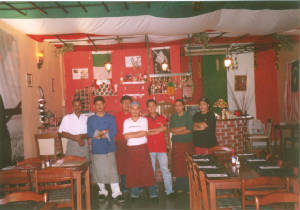 |
Welcome to our web site! On this home page, we'll introduce our business and highlight important areas on our
site. Here is an example of a style we may use.
In remote times, the island of Capri was joined to the surrentine peninsula. Neolithic and the Bronze
age artefacts have been found in the "Grotta delle Felci".  The remains of the ramparts of a seaside settlement and the so-called "Scala Fenicia", connecting this settlement
to one lying further uphill, date from Greek times. The actual residential use of Capri, however, begins with the emperors
Augustus and Tiberius. The better preserved sites, viz. Villa Iovis and "Palazzo a Mare" in Capri,
Villa Damecuta in Anacapri, go back to this period. In the first, which lies on the promontory delimiting Marina
Grande, the remains of the imperial, servant and thermal quarters, lying around the imposing water reservoirs, are still visible.
The vestiges of the "Palazzo a Mare" are not as well preserved, having been incorporated into modern buildings, with the exception
of the seaside quarter, still partially visible in the modern "Bagni di Tiberio". At the north-west extremity of the island,
one can admire the residential quarters of the Villa Damecuta, which has not been explored systematically up to now. The "Grotta
Azzurra" ("Blue Cave"), an intriguing Roman nymphaeum where statues have been found, was possibly used as the moorings
to a villa probably connected with the ruins visible in the area of Gradola. The so-called "Grotta dell’Arsenale"
("Cave of the Arsenal") near Marina Piccola was probably also a nymphaeum, while the "Grotta di Matromania"
was a seat of the cult of the Magna Mater. The remains of the ramparts of a seaside settlement and the so-called "Scala Fenicia", connecting this settlement
to one lying further uphill, date from Greek times. The actual residential use of Capri, however, begins with the emperors
Augustus and Tiberius. The better preserved sites, viz. Villa Iovis and "Palazzo a Mare" in Capri,
Villa Damecuta in Anacapri, go back to this period. In the first, which lies on the promontory delimiting Marina
Grande, the remains of the imperial, servant and thermal quarters, lying around the imposing water reservoirs, are still visible.
The vestiges of the "Palazzo a Mare" are not as well preserved, having been incorporated into modern buildings, with the exception
of the seaside quarter, still partially visible in the modern "Bagni di Tiberio". At the north-west extremity of the island,
one can admire the residential quarters of the Villa Damecuta, which has not been explored systematically up to now. The "Grotta
Azzurra" ("Blue Cave"), an intriguing Roman nymphaeum where statues have been found, was possibly used as the moorings
to a villa probably connected with the ruins visible in the area of Gradola. The so-called "Grotta dell’Arsenale"
("Cave of the Arsenal") near Marina Piccola was probably also a nymphaeum, while the "Grotta di Matromania"
was a seat of the cult of the Magna Mater.
|



 The remains of the ramparts of a seaside settlement and the so-called "Scala Fenicia", connecting this settlement
to one lying further uphill, date from Greek times. The actual residential use of Capri, however, begins with the emperors
Augustus and Tiberius. The better preserved sites, viz. Villa Iovis and "Palazzo a Mare" in Capri,
Villa Damecuta in Anacapri, go back to this period. In the first, which lies on the promontory delimiting Marina
Grande, the remains of the imperial, servant and thermal quarters, lying around the imposing water reservoirs, are still visible.
The vestiges of the "Palazzo a Mare" are not as well preserved, having been incorporated into modern buildings, with the exception
of the seaside quarter, still partially visible in the modern "Bagni di Tiberio". At the north-west extremity of the island,
one can admire the residential quarters of the Villa Damecuta, which has not been explored systematically up to now. The "Grotta
Azzurra" ("Blue Cave"), an intriguing Roman nymphaeum where statues have been found, was possibly used as the moorings
to a villa probably connected with the ruins visible in the area of Gradola. The so-called "Grotta dell’Arsenale"
("Cave of the Arsenal") near Marina Piccola was probably also a nymphaeum, while the "Grotta di Matromania"
was a seat of the cult of the Magna Mater.
The remains of the ramparts of a seaside settlement and the so-called "Scala Fenicia", connecting this settlement
to one lying further uphill, date from Greek times. The actual residential use of Capri, however, begins with the emperors
Augustus and Tiberius. The better preserved sites, viz. Villa Iovis and "Palazzo a Mare" in Capri,
Villa Damecuta in Anacapri, go back to this period. In the first, which lies on the promontory delimiting Marina
Grande, the remains of the imperial, servant and thermal quarters, lying around the imposing water reservoirs, are still visible.
The vestiges of the "Palazzo a Mare" are not as well preserved, having been incorporated into modern buildings, with the exception
of the seaside quarter, still partially visible in the modern "Bagni di Tiberio". At the north-west extremity of the island,
one can admire the residential quarters of the Villa Damecuta, which has not been explored systematically up to now. The "Grotta
Azzurra" ("Blue Cave"), an intriguing Roman nymphaeum where statues have been found, was possibly used as the moorings
to a villa probably connected with the ruins visible in the area of Gradola. The so-called "Grotta dell’Arsenale"
("Cave of the Arsenal") near Marina Piccola was probably also a nymphaeum, while the "Grotta di Matromania"
was a seat of the cult of the Magna Mater.
